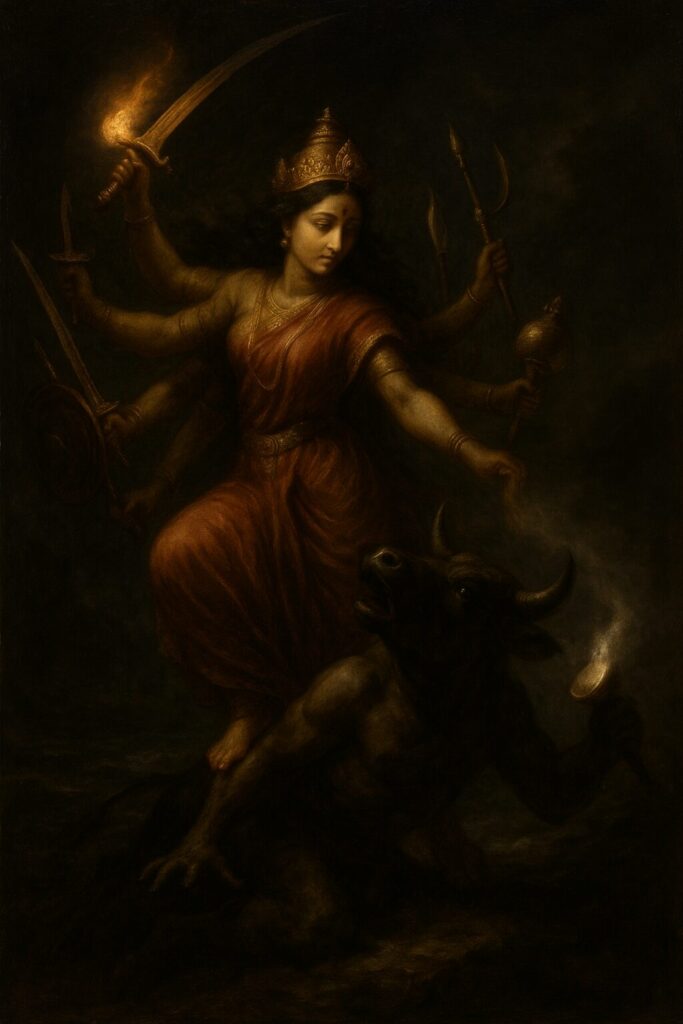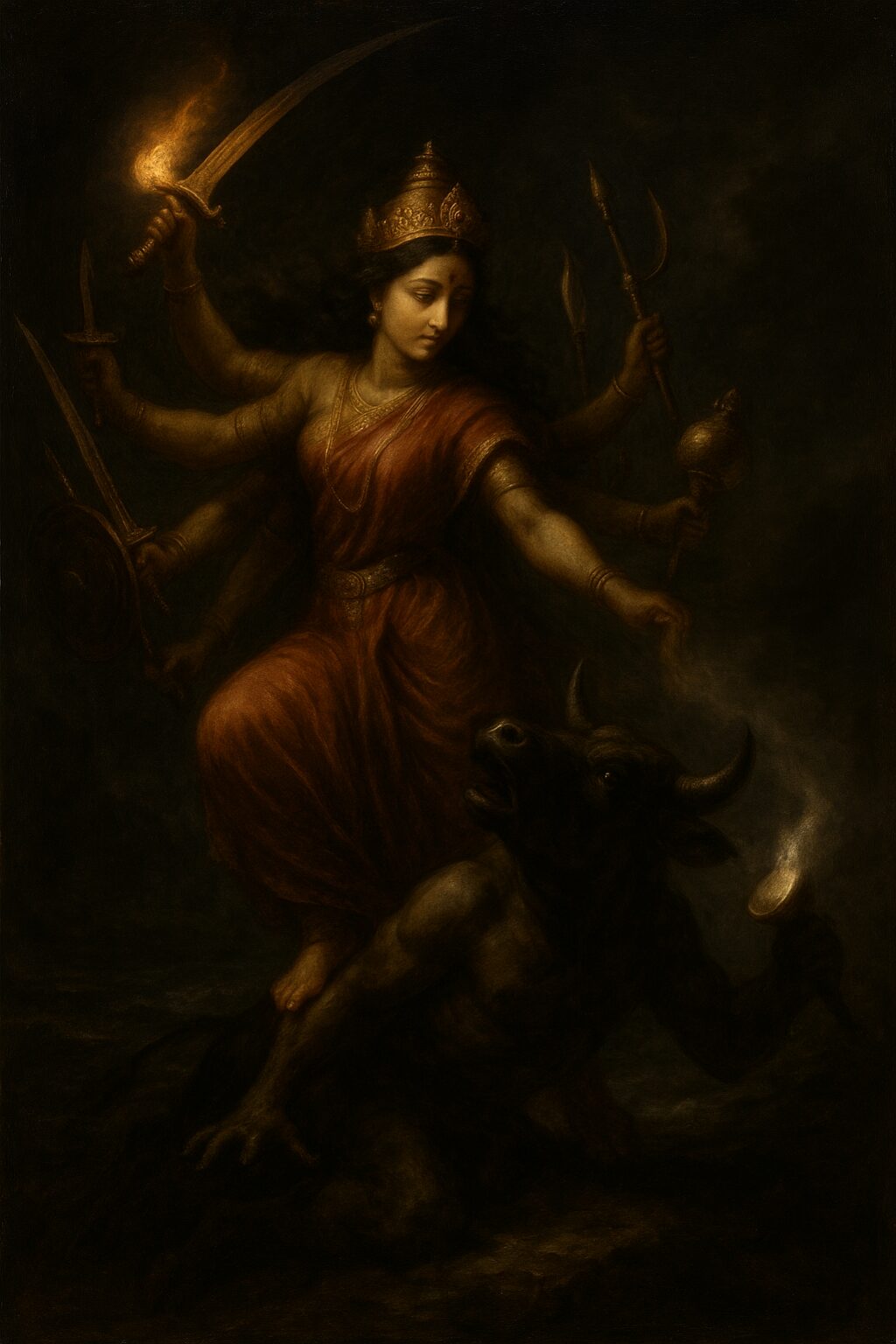Tuesday, September 30 2025 (Maha Ashtami, the eighth day of Navaratri)

Durga Ashtami arrives when the year bends toward descent. The autumn equinox just has passed, the nights lengthen, and a subtle inwardness takes hold of the air. In the Ompyrean Calendar, this resonates with the transition of Fire into Air: the time has come to turn from outward struggle into inward invocation. Instead of expending energy in external battles, you begin to channel that same force into subtle, spiritual practice such as, mantra, prayer and meditation (all of which involve calling on Shakti). It’s a seasonal/ritual shift: autumn (Durga Ashtami) is when energy that was fiery and outward must now be gathered inward, refined into breath and word.
It is the time when the soul, tested by darkness, receives the vision of Shakti’s weapons so to be wielded for the battle within.
Stop fighting outwardly, and start invoking inwardly. Transform your energy from external action into inner prayer.
Durga Ashtami recalls the moment when the Goddess in Her most radiant form, Mahishasura Mardini, faced the demon of inertia and arrogance. Mahishasura represents not merely evil, but the dull, shape-shifting resistance of the lower nature that refuses transformation. Each of Her ten hands bore an offering of the gods: Vishnu’s discus, Shiva’s trident, Agni’s flame, Indra’s thunderbolt. These are not weapons of destruction only, but powers of discernment, courage, clarity, and force of truth. Her victory is mythic, but also psychocosmic: it instructs us that spiritual life requires a conscious marshalling of all energies—mental, vital, physical, psychic—toward one divine aim.
Through the Ompyrean lens, Durga Ashtami belongs to the Vital-Being quadrant: it tests whether the energies of life serve chaos or consciousness. The day carries an Ananda inflection: joy wrested from the overcoming of inertia. Within a Yoga framework, it echoes Savitri’s combat with Death: a woman standing sovereign against the abyss, affirming that transformation belongs to Earth itself. Elementally, it is Fire disciplined into Air: the flame of tapasya becoming mantra, sound and in vocation.
As mentioned, this day belongs to the Vital–Being quadrant, where the central question is whether the raw currents of life-energy will dissolve into chaos or be gathered into a single, upward movement. On this day, the test is not intellectual alone, nor purely devotional. It is the battle of energies themselves, demanding that they be harnessed and disciplined toward the soul’s aim.
Seasonally, the day lies at the turning where Fire bends into Air. The flame that once surged outward in action must now be refined, made subtle, translated into invocation and breath. What was heat becomes mantra, what was blaze becomes clarity of voice. Here the weapon of the Goddess is not only the sword, but also the conch and the breath. Will carried on the wings of chosen fate.
In the key of Sat–Chit–Ānanda, Durga Ashtami carries the note of Ānanda. Joy here is not a light indulgence but the deep exaltation that comes from confronting inertia and passing through it. Resistance, once pierced, yields a serenity that is radiant rather than passive. The joy of Shakti realized.
Durga Ashtami is therefore not only a commemoration of the Goddess’s victory, but also a reminder that our own battles must shift from restless outer striving to conscious inner alignment. The power that once blazes outward as effort is most potent when gathered, refined, and offered upward as invocation. To live this day well is to let Durga’s weapons become our disciplines, her courage our inner stance, and her joy our assurance that every resistance can be overcome.
Durga’s ten weapons reveal themselves as the ten disciplines required to awaken a human being. The sword of discrimination belongs to the intellectual center, cutting illusion with clarity. The bow and arrow serve the moving center, teaching focus, economy, and precision. The mace grounds the instinctive center in force and endurance, while the conch vibrates in the emotional center as the sound that awakens and unites. The spear channels the vital fire into disciplined striving, and the axe severs old habits and attachments that bind us to sleep. The shield guards essence with vigilance, protecting what is true, while the lotus blossoms as the psychic center, the pure unfolding of soul. Above these, the trident pierces duality with the higher emotional will, and the discus circles with the higher intellectual vision that sees wholes rather than fragments. Mahishasura is the inertia that keeps these centers scattered and asleep; Durga is the force that gathers them under one conscious aim. To remember Her on Ashtami is to remember the Work itself: the marshalling of all functions, the transmutation of action into invocation, and the victory of consciousness over sleep.

